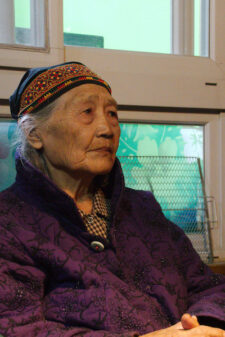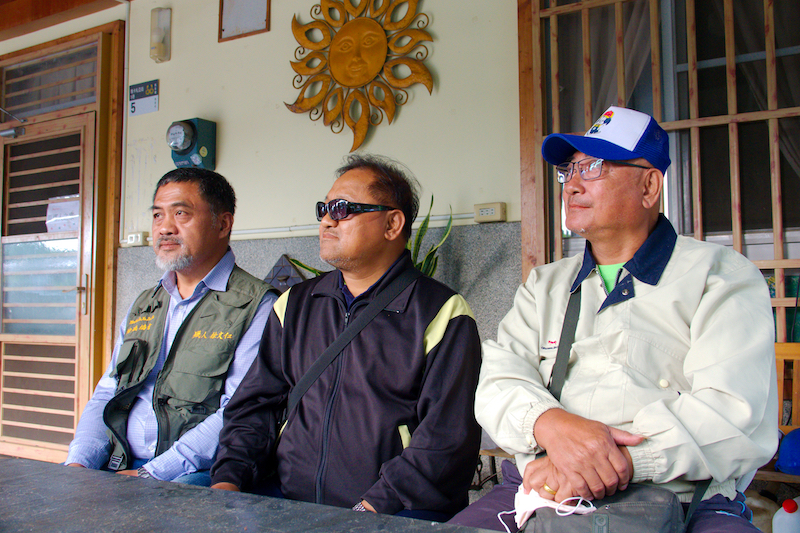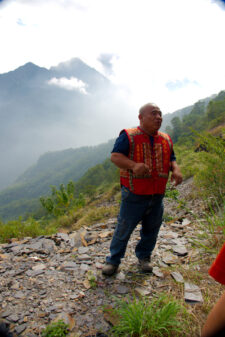“We couldn’t be evacuated in time,” said Tung Wen-ming, community officer in the southern Taiwanese town of Rinari. He recalls the day of 8 August 2009. One of the deadliest typhoons in Taiwan’s history, Typhoon Morakot, struck Taiwan and devastated his former home, the indigenous village of Makazayazaya, a thousand metres above sea level on the slopes of Baibin Mountain in Pingtung County.
The storm washed out the road to the town, bringing huge swathes of mountainside sliding down to the valley below, taking with them over 600 lives, many of them in the mountains surrounding Makazayazaya in Pingtung and neighbouring Kaohsiung.
Tung and some 500 members of the Paiwan indigenous group who populated Makazayazaya were lucky enough to survive the devastation. They were left to evacuate on their own as Morakot dumped up to 2,500mm of rain on areas of the south, leaving behind their traditional farmlands and abandoning their ancestral burial grounds.
Tung, along with Hsieh Wen-yen, head of the local Paiwan hunting association, were among those in charge of the village’s emergency evacuation procedures. The county government told them they were on their own, for now. “The government asked us to evacuate to the elementary school gym,” Hsieh told Climate Home News.
Months later they were eventually moved to the nearby mountain village of Rinari, which is vulnerable to landslides and typhoons. Between three and four typhoons on average strike Taiwan each year, causing billions of pounds worth of damages. Owing to Taiwan’s steep terrain and regular seismic activity, it is one of the most landslide-prone countries in the world. Most occur in sparsely populated areas of the mountains, such as the area around Makazayazaya and Rinari, and every year, lives are lost.
None of those who left Makazayazaya in the days after Morakot knew then they would not set foot in their traditional homeland for over a decade. Today, they are still trying to retake their ancestral home, as a lack of jobs in Rinari, lack of access to traditional farmlands, and a new town they feel culturally disconnected from leave the Paiwan alienated in their own homes.
Due to lack of resources on their part and a lack of political will on the side of the government, they remain unable to return to their old village.
After the storm
Most in Makazayazaya hunkered down during the storm, riding it out, unable to leave as the rains and wind washed out the road and eviscerated the mountainside. In the days that followed, as the storm dissipated, they decamped to the school on the advice of government officials. The mountain, rich in the loose slate the Paiwan once made their homes from, was unstable following the heavy rains.
Landslides were a major concern. Just across the valley from Makazayazaya, where through flows the Ailiao River, the village of Kucapungane, populated by the indigenous Rukai people, was completely destroyed.
Dabu Lavakavu, a Paiwan guide who also left Makazayazaya behind, believes this was the land taking its revenge in a country struggling with human-generated land and air degradation.
According to the Environmental Performance Index, Taiwan ranks 140 out of 178 in exposure to PM2.5, toxic fine particulate matter, due to the rapid industrialisation the country has undergone in recent decades. “If you take something from [the land],” said Lavakavu, “it will ask for something in return.”
After the evacuation some, like Elleng Vavulengan, leader of the Makazayazaya Paiwan, wound up staying at Bei Yei Elementary’s temporary shelter for months. After their stay at the school, they were told they could relocate to a new town, in the initial stages of planning.
The town was built over the course of a year by the Pingtung county government and the nonprofit World Vision Taiwan at a cost of $1 billion New Taiwan dollars ($36 million). The name was Rinari, a Paiwan word meaning “we greet each other with politeness” – appropriate for a place that was once an important site of trade between the area’s indigenous peoples and Han Chinese immigrants.

Elleng Vavulengan
Vavulengan knew Rinari because the land it occupies had traditionally belonged to her family, in the days before the Japanese Colonial Era (1895-1945). After World War II, the land was appropriated by the government-run Taiwan Sugar Corporation (TSC).
For 30 years, the Makazayazaya Paiwan had been lobbying for a right to relocate to the Rinari area, Vavulengan’s daughter Eljayum , an elected member of the Rinari town council, told Climate Home News.
“When we were in the old community, the roads were constantly washed out by rain,” Vavulengan said “We submitted the last petition to move four days before Typhoon Morakot hit.”
Rinari, where the people of Makazayazaya still live today, along with Paiwan and Rukai people from two other villages that were abandoned after Morakot, sits on a mostly flat expanse of 30 hectares, leveled by machinery some 200 metres down the mountain and 20 to 30 minutes by vehicle from their old homes. The population sits somewhere around 1,500, making Rinari the largest indigenous settlement in Taiwan.
From the outside looking in, Rinari appears to be a model mountain village. The homes, given free of charge to those who lost theirs to the typhoon, have the appearance of European lodges, and come in two types, a bungalow model and a basic two-story duplex. But the people forced to relocate there are facing crises on multiple fronts. For one, there is a dearth of jobs, said Eljayum Vavulengan.
“For the men, they will have a job like driving trucks, delivering food. Or they will help building houses, fixing roofs,” she told Climate Home News. “For the women, some of them stay in the house or take daily jobs like cleaning, or in a restaurant.”

Left to right, Paiwan hunting association head Hsieh Wen-yen, Rinari community leader Tang Jian-sheng, and Rinari community officer Tung Wen-ming. (All photos: Tobie Openshaw)
Mounting threats
Lack of jobs is one thing; environmental threats, exacerbated by climate change, another. Li Hsin-chi, researcher at the National Science and Technology Center for Disaster Reduction (NCDR), has been studying and assessing rainfall and landslide risk in Taiwan for the past ten years. According to his projections, the amount of precipitation in the Rinari area will increase anywhere from 5 to 10% by the end of the century.
“They still face a lot of threats from landslides,” said Li, adding that the risk of those landslides will increase in the coming years.
The Paiwan also feel a strong sense of cultural disconnect from Rinari, built, they say, without their input.
“[The government] just built it how they wanted it,” Eljayum Vavulengan, the mamazangilan’s granddaughter, goes on. In Makazayazaya, she says, “We had land next to our houses so we can grow our crops, and a small yard so we can gather round together. But [in Rinari], there was no land. When some of the elders first moved to Rinari, they had nothing to do. Some just passed away. I think it’s because they couldn’t deal with the emotions.”
Farming has since time immemorial been culturally important to the Paiwan, with millet their staple crop. The fight for rights to their traditional farmland is ongoing. The Makazayazaya Paiwan still commute from Rinari to their farms in the old village during the growing and harvest season. But there is another plot, next to Rinari, once belonging to the Paiwan, still held by TSC.
The plot is small, 70 ping (231.35 square metres). In 2011, Rinari community leader Tang Jian-sheng, who also goes by his Paiwan name, Cemelesai, formed the Typhoon Morakot Human Rights Committee, to lobby for the return of the Rinari plot.
“We tried a lot of times,” said Tang, “but there is a policy that restricts us from receiving the land, and also restricts the government from selling it. So, we’re working on that.”
The reason why TSC has thus far declined to return or sell the small plot of farmland back to the Paiwan people of Rinari remains unclear. The corporation declined to comment.
“I don’t know any law that would prevent the sale of such a small piece of land,” Shu-mei Huang, associate professor at the National Taiwan University, told Climate Home News. She pointed to Article 53 of the National Property Act, which states that land with no specified use and less than 1,650 square metres in size (the Rinari plot is 230 square metres) shall be sold by public tendering.
“As a state enterprise, Taiwan Sugar is regulated by the act,” said Huang.
Professor Sasala Taiban of the department of sociology at National Sun Yat-Sen University specialises in the study of Paiwan traditional territories. He told Climate Home News that since the land Rinari occupies was nationalised by the incoming Japanese and Nationalist governments, policies have changed to allow for more indigenous reserves. “But the percentage is very small,” he said. “With the colonial mindset, the possibility of the state returning the land to the aborigines is almost non-existent,” he said.
“We have no place to bury our dead, and we have no fields for crops,” Hsieh Wen-yen said, summing up the problems his people still face to this day. “We also need more space for our descendants,” he said, noting the homes in Rinari are starting to deteriorate. He worries they won’t survive the next Morakot.
Returning home
No one is allowed to build additions to the homes in Rinari, nor are there government plans to build new housing nor any commercial properties. The government told Climate Home News that they will allocate funds for housing repairs. If the younger generations decide to have families, they have to move away.
“We wish the government could have offered us the right to rebuild or alter the houses as we see fit,” says community Leader Tang. “Long term, there are not many opportunities for the youth here,” he said. “The most potential is in the tourism industry, so we wish we could develop that.”
The roadblock to developing the tourism industry, or any other for that matter, is the fact that no homes in Rinari are zoned for commercial purposes. With no concession to build new structures, and a convoluted and lengthy process for approving private homes for use as tourist homestays, so far just one home in Rinari has been allowed to operate as a rental home.
“We have to pay for all of the inspections and licensing fees and hire a licensed inspector to come and check everything out and make sure everything is up to code. That’s very expensive,” said Tang.
Cai Wen-jin, the vice director of the department of indigenous affairs in Pingtung, said Rinari homes are durable and able to withstand earthquakes of a magnitude between 7 and 8 on the Richter scale. From 2021 through to 2023, $45 million New Taiwan dollars ($1.6m) has been allocated for housing repairs in Rinari.

Dabu Lavakavu
Cai said the county government does not have any plans for business development in Rinari.
He also said that, after years of consistent lobbying, should residents of Rinari now wish to move back to Makazayazaya, they may do so. However, there is a catch.
“They can move back to the place where they used to live as long as they return the permanent houses to the government,” Cai said.
What this means is that, at the cost of repairing or even rebuilding homes left neglected for 12 years in Makazayazaya, and at the loss of the places they have called home in Rinari for that same length of time, people can return to their old village.
“The reality is that not everyone here can afford that,” said Tung Wen-ming.
The people of Rinari continue to try and make things better for themselves, in spite of the lingering threats to their culture and livelihood issues related to climate change have placed before them. For councilwoman Vavulengan, her priority in the coming months is geological surveys, which will help determine if any expansion can be made to Rinari, both for residential and commercial purposes, should the government ever allow it.
“In the future we’ll have to rely on ourselves to build houses for ourselves,” she said. “I just pray to god we’ll never experience something like Morakot again.”
In the school at Rinari, constructed at Vavulengan’s insistence, children are taught the Paiwan language. They have a cultural class in which they learn things like the origin story of their people, how they became known as “the children of the sun”. Elders can take continuing education courses to keep busy.
Eljayum Vavulengan wants to stay in Rinari following completion of her master’s degree in Pingtung City. She hopes to turn her grandmother’s old house in Makazayazaya, still standing, into a museum.
“I feel our culture is passing away,” she said. “I want to come back here, and I want to stay here. I feel like if I leave, no one is going to help my community or my family.”
As for the older Vavulengan, she has an informal business selling coffee beans, which she sorts and roasts in large screen racks on the front porch, a slate totem in front indicating this is the home of the Paiwan leader. Like all the elderly of Rinari, she would go back to Makazayazaya in an instant, if she could. It is important for the Paiwan to die near the burial ground of their ancestors, but it remains uncertain if they will ever return, she said.
“It’s where I was born, and I miss it. Everything was good.”
Main image by Tobie Openshaw: Eljayum Vavulengan, granddaughter of the leader of the Makazayazaya Paiwan. This article is part of a climate justice reporting programme supported by the Climate Justice Resilience Fund.